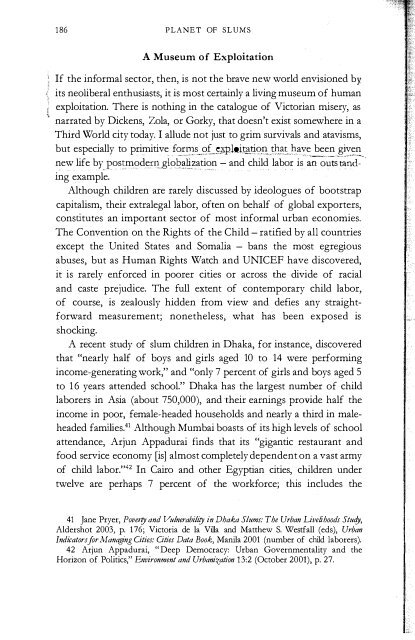Untitled - Rebel Studies Library
Untitled - Rebel Studies Library
Untitled - Rebel Studies Library
You also want an ePaper? Increase the reach of your titles
YUMPU automatically turns print PDFs into web optimized ePapers that Google loves.
186 PLANET OF SLUMS<br />
A Museum of Exploitation<br />
i If the informal sector, then, is not the brave new world envisioned by<br />
its neoliberal enthusiasts, it is most certainly a living museum of human<br />
exploitation. There is nothing in the catalogue of Victorian misery, as<br />
narrated by Dickens, Zola, or Gorky, that doesn't exist somewhere in a<br />
Third World city today. I allude not just to grim survivals and atavisms,<br />
but especially to primitive frt?s_gL_lQi!ti(),11. tJ:?:tllave been given<br />
new life by postmoder11..glob.?:li.zation - and child labor is ;;-;ts-td-<br />
ing example.<br />
'. '<br />
Although children are rarely discussed by ideologues of bootstrap<br />
capitalism, their extralegal labor, often on behalf of global exporters,<br />
constitutes an important sector of most informal urban economies.<br />
The Convention on the Rights of the Child - ratified by all countries<br />
except the United States and Somalia - bans the most egregious<br />
abuses, but as Human Rights Watch and UNICEF have discovered,<br />
it is rarely enforced in poorer cities or across the divide of racial<br />
and caste prejudice. The full extent of contemporary child labor,<br />
of course, is zealously hidden from view and defies any straightforward<br />
measurement; nonetheless, what has been exposed is<br />
shocking.<br />
A recent study of slum children in Dhaka, for instance, discovered<br />
that "nearly half of boys and girls aged 10 to 14 were performing<br />
income-generating work," and "only 7 percent of girls and boys aged 5<br />
to 16 years attended school." Dhaka has the largest number of child<br />
laborers in Asia (about 750,000), and their earnings provide half the<br />
income in poor, female-headed households and nearly a third in maleheaded<br />
families.41 Although Mumbai boasts of its high levels of school<br />
attendance, Arjun Appadurai finds that its "gigantic restaurant and<br />
food service economy [is] almost completely dependent on a vast army<br />
of child labor."42 In Cairo and other Egyptian cities, children under<br />
twelve are perhaps 7 percent of the workforce; this includes the<br />
41 Jane Pryer, Poverty and Vulnerability in Dhaka Slums: The Urban Livelihoods Stutfy,<br />
Aldershot 2003, p. 176; Victoria de la Villa and Matthew S. Westfall (eds), Urban<br />
Indicators jor Managing Cities: Cities Data Book, Manila 2001 (number of child laborers).<br />
42 Arjun Appadurai, "Deep Democracy: Urban Governmentality and the<br />
HOrizon of Politics," Emironment and Urbanization 13:2 (October 2001), p. 27.<br />
A SURPLUS HUMANITY? 187<br />
thousands of street children who gather and resell cigarette butts (a<br />
pack a day otherwise costs half of a poor man's monthly salary).43<br />
The world capital of enslaved and exploited children, however, is<br />
probably the Hindu sacred city of Varanasi (population 1.1 million) in<br />
Uttar Pradesh. Famed for its textiles as well as for its temples and holy<br />
men, Varanasi (Benares) weaves its carpets and embroiders its sans with<br />
the bonded labor of more than 200,000 children under the age of 14.44<br />
In exchange for tiny loans and cash payments, incredibly poor rural<br />
Dalits and Muslims sell their children - or their entire families - to<br />
predatory textile contractors. According to UNICEF, thousands of<br />
children in the carpet industry are "kidnapped or lured away or pledged<br />
by their parents for paltry sums of money."<br />
Most of them are kept in captivity, tortured and made to work for 20<br />
hours a day without a break. Little children are made to crouch on their<br />
toes, from dawn to dusk every day, severely stunting their growth during<br />
formative years. Social activists in the area find it hard to work because<br />
of the strong Mafia-like control that the carpet loom owners have on the<br />
area. 45<br />
Varanasi's silk san' industry, investigated by Human Rights Watch, is no<br />
better: "The children work twelve or more hours a day, six and a half<br />
or seven days a week, under conditions of physical and verbal abuse.<br />
Starting as young as age five, they earn from nothing at all to around<br />
400 rupees (US $8.33) a month." In one workshop, researchers discovered<br />
a 9-year-old chained to his loom; everywhere they saw young boys<br />
covered with burn scars from the dangerous work of boiling silkworm<br />
cocoons, as well as little girls with damaged eyesight from endless hours<br />
of embroidering in poor lighting.46<br />
Another notorious center of child labor is India's glass capital:<br />
Firozabad (population 350,000), also in Uttar Pradesh. It is bitterly<br />
ironic that the glass bangles beloved by married women are made by<br />
43 Nedoroscik, The City oj the Dead, p. 64.<br />
44 Zama Coursen-Neff, Small Change: Bonded Child Labor in India's Silk Industry<br />
(Human Rights Watch Report 15:2, January 2003), p. 30.<br />
45 UNICEF, The State oj the World} Children 1997, Oxford 1998, p. 35.<br />
46 Coursen-Neff, Small Change, pp. 8, 30.


